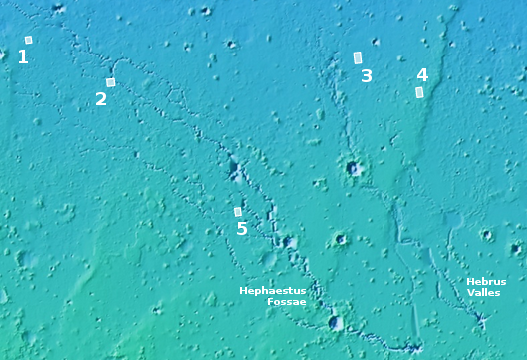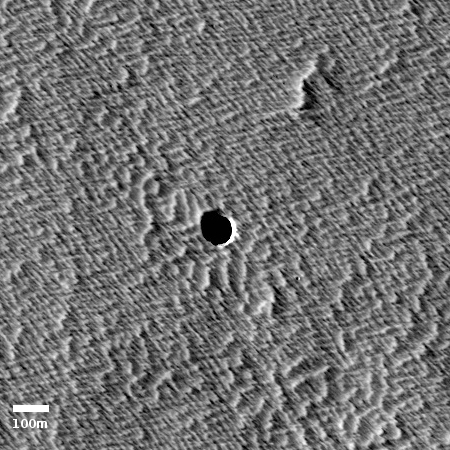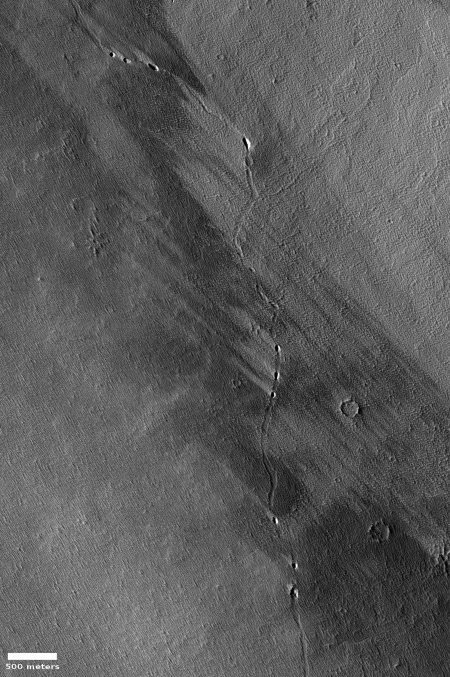More pits found on Mars

Since 2018 I have made it a point to document every new pit image taken on Mars by the high resolution camera on Mars Reconnaissance Orbiter (MRO). The list of can be found at the bottom of this post.
In the most recent release from MRO, a number of new pits were photographed. All continue to suggest that Mars has a lot of underground voids, some caused by lava flow, some by tectonic activity, some by water ice erosion, and some almost certainly caused by processes we don’t yet know. The images also suggest that we have only identified a small fraction of those underground voids.
The first image to the right, cropped to post here, shows the one new pit in the northern lowlands of Utopia Planitia, near a series of meandering channels and canyons dubbed Hephaestus Fossae and Hebrus Valles.
This appears to be the fifth such pit found in this region. Previously I had documented the first four. The overview map to the right adds this fifth pit. Note how the pit is much closer to the head of Hephaestus. In the full image you can see fissures both to the north and south, as well as many nearby aligned depressions, suggesting the existence of more underground passages, some possibly linked to voids under this very pit.
The pit itself seems filled, with no apparent side passages, though to the southwest there might be something leading off in the shadows.
The overall terrain in this region, including these pits, the fissures, and the many aligned depressions, strongly suggests a lot of underground voids. As I noted in 2019:
Scientists are not sure what caused these channels. Several have proposed that they could have been caused by catastrophic floods of water, melting because of heating from the volcano. Others suspect these rills are indications of lava flows coming down from Elysium Mons, forming lava tubes. In either case there appears no consensus.
I would add that newer research might replace catastrophic floods of water with some form of massive glacial activity across large vast areas of these plains. This new possibility is very preliminary, and I mention it only because I have gotten a sense from scientists that this is now being considered, though no one as far as I know has yet articulated it in depth in any published paper.

Two of other newly photographed pits are located, like almost all known pits on Mars, near the large volcanoes of the Tharsis Bulge. The context map to the right shows all the imaged pits I’ve documented so far, with the two new ones indicated by the white boxes labeled “skylight” and “lava tube.” Both are northwest of the volcano Arsia Mons, and both have features that suggest they are related to past lava flows coming down from that volcano.
The next image below and to the right, cropped to post here, shows the skylight. Though it is all alone on a relatively featureless plain, on the full image directly to the south about a mile away is a string of depressions.
Next is actually not one pit but a string of pits aligned to strongly suggest the existence of an underground lava tube, very similar and near to another string of pits previously shown in a 2019 post and located by the nearest black box just to the northwest.
If you click on the full image, you will see that this meandering depression extends off the image both to the north and south. Though it might be documented more completely in wider lower resolution images, the high resolution camera on MRO has not yet covered it entirely. For all we know, it might even connect with the lava tube to the northwest. Or it could be a second parallel tube. In looking at most of the other high resolution images taken by MRO in this area, it appears there are a lot of similar lava tube features.
Altogether, the pit and depressions for both images point uphill to the volcano Arsia Mons.
The last pit image released is shown below and to the right. It shows another pit aligned with another string of depressions. In this case the pit is found on the northwest flank of the giant volcano Elysium Mons, located far to the west of the Tharsis Bulge, on the other side of Mars’ volcano country.
Once again, the string suggests a existence of a passage below. And since this is on the flanks of a volcano, the first assumption is that the voids were created by a lava tube flow. A review of all nearby MRO high resolution images shows many similar pits and depression strings, but also suggests that the voids were created not by lava flows but by cracking caused as the ground bulged upwards from the pressure of the magma chamber below.
We would need a planetary geologist to help settle this. It would also help if that planetary geologist could spend some time at the location, with a rock hammer, doing some in situ geology research.
All previous pit posts since 2018:
On Christmas Eve 1968 three Americans became the first humans to visit another world. What they did to celebrate was unexpected and profound, and will be remembered throughout all human history. Genesis: the Story of Apollo 8, Robert Zimmerman's classic history of humanity's first journey to another world, tells that story, and it is now available as both an ebook and an audiobook, both with a foreword by Valerie Anders and a new introduction by Robert Zimmerman.
The print edition can be purchased at Amazon or from any other book seller. If you want an autographed copy the price is $60 for the hardback and $45 for the paperback, plus $8 shipping for each. Go here for purchasing details. The ebook is available everywhere for $5.99 (before discount) at amazon, or direct from my ebook publisher, ebookit. If you buy it from ebookit you don't support the big tech companies and the author gets a bigger cut much sooner.
The audiobook is also available at all these vendors, and is also free with a 30-day trial membership to Audible.
"Not simply about one mission, [Genesis] is also the history of America's quest for the moon... Zimmerman has done a masterful job of tying disparate events together into a solid account of one of America's greatest human triumphs."--San Antonio Express-News






I’ll take the opportunity to point interested readers to the book “From Cave Man to Cave Martian: Living in Caves on the Earth, Moon and Mars” (2019). It covers exploration of and living in off-world caves, search for life, power supply, life support, robotics, new materials etc. the whole thing. Passionate but not opinionated, a pleasant read with an extensive reference section.
https://www.amazon.com/Cave-Man-Martian-Living-Springer/dp/3030054071/
Love it … “Previous Pit Posts” ….
Perfect !
Now about that rock hammer Mr. Z. …
I will have to dust off my copy of “A Field Guide to Rocks and Minerals” – F. Pough, and visit the Lassen lava tubes again.
A.
Ian, I bought and read the Kindle on your recommendation. I gave it three stars on Amazon. (Wish I were a better writer… but the Submit button has been pressed.)
This guy’s one of the heroes of the early space program (and I say so in the review), but I’m afraid he’s out of date. My main complaint is the complete omission, not one single mention, of Elon Musk or his companies (other than two passing, insubstantial instances of SpaceX). Since late 2016, no one writing about humans on the Moon or Mars should make that mistake–even if their only purpose is to criticize, deride, or dismiss Musk. Instead, the book is chock full of what I call NASA-speak, and it’s obvious the author is totally immersed in the old-school way of viewing space exploration–which is no surprise, given his history. After all the pages and pages of bulleted lists of this and that low-priority, underfunded NASA or contractor study, discussion of the actual issues involved in making use of lunar and Martian lava tubes is given relatively little attention. The survey of terrestrial caves was the most interesting part for me.
The omission of Musk is stupefying, actually. Look at the guy’s companies–SpaceX, Tesla/Solar City, The Boring Company. They are like the three legs of a stool, providing all the technology needed to establish bases on other planets. They are all well-funded and advancing incredibly fast. But “Dutch” ignores them completely, instead simply listing a mishmash of small efforts that, in the main, have little to do with lava-tube habitats. It’s too bad.
I said in the review I’m a fanboy, and it’s true. But you don’t have to be a fanboy to see what’s obvious.
Patrick,
Thanks for the feedback, I assumed the content was more useful. Sorry if my recommendation was too tempting and the book didn’t deliver.
Instead, the book is chock full of what I call NASA-speak, and it’s obvious the author is totally immersed in the old-school way of viewing space exploration–which is no surprise, given his history.
True. And it’s true for many who grew up in the “old ways.” I decided to judge not too harshly and focus on the things I find useful. Many of the things he writes about I think are still valid or at least useful to consider and I liked the references. It’s not that all prior thoughts by NASA and “classic space” are worthless.
That being said, how much would Musk’s three companies change the early exploration efforts? Leaving the political/legal aspects aside, before anyone starts digging into the Martian ground big time to build subsurface bases, one needs to validate the ISRU equipment on-site, install and test and scale up the solar power plants, explore robotically the caves and surrounding ground, test the mining machinery etc. Even with all that in mind, I found his lists and descriptions useful–either to see whether I need to consider an item or to scratch that concern out of my books.
What would you be interested in sending to the Moon or Mars early on?
Hi Ian,
Don’t get me wrong! I appreciated the recommendation—always on the lookout for new space books.
I emphasized what I didn’t like, at the expense of what I did. All these efforts by researchers, both in and outside of NASA, are valuable. Musk and Shotwell have said many times how valuable NASA is to SpaceX. NASA is the only entity in the world to have landed humans on the Moon, put working landers and rovers on Mars, and visited every single planet in the Solar System. NASA is legend. But I think the author errs in not acknowledging that NASA human spaceflight, at least prior to Jim Bridenstine, had become moribund, stuck in process, fearful of innovation, and subject to the whims of parochial politicians and their corporate backers. Clearly, Elon Musk is the leader in terms of vision and accomplishment in spaceflight these days. And in 2018/19/20, to write an entire book about human habitations on the Moon and Mars, without even mentioning, much less discussing, Elon Musk, is a huge mistake.
I’m not really competent to say how lunar bases should be constructed. But I’ll do it anyway. Power is number one. So the first payloads should include solar arrays, batteries, power management and distribution systems, and the means to deploy them. Second, autonomous vehicles, including cranes and “earth” movers. Third, surface habitats and exploratory crews. Fourth, tunnel boring machines for radiation-hardened permanent habs, and ISRU capabilities for water extraction and fuel production.
I’m certain to be overlooking many factors and difficulties, but I do believe putting lava tubes in the critical path for lunar exploration and settlement only ensures that decades of research must be completed prior to the first landing. There are just too many unknowns, too many problems, too many variables. A tunnel boring machine can accomplish the same task—providing safe shelter—with far fewer questions to be answered, and problems to be solved, beforehand.
Patrick,
I do believe putting lava tubes in the critical path for lunar exploration and settlement only ensures that decades of research must be completed prior to the first landing. There are just too many unknowns, too many problems, too many variables. A tunnel boring machine can accomplish the same task—providing safe shelter—with far fewer questions to be answered, and problems to be solved, beforehand.
Excellent point. We cannot wait until all results are in from exploration and better start building and creating facts ASAP.
I wonder what opposition this mentality/approach will trigger in the scientific and policy community with its widespread love for the precautionary principle, anti-privatization stance, and such. I know quite a few who want to explore everything carefully, preserve celestial bodies as they are (free from human intervention), and only make things accessible to “eligible experts” who can deal with it “responsibly.”
We obviously agree on what to send early on. What also interests me is what could be payloads we should send early that aren’t on the usual lists or that are neglected? Something essential or super useful we might miss and discover only later that it would be a good idea. Even better, something that might take some time to develop and that we should work on now, not once we realize that it’s missing. Any candidates?
A lot more Volcanic Activity on the Red Planet then we ever expected maybe even more
Thanks Ian.
Wow, I wish I could answer questions like that, I’d be making a lot more money!
One thing I’m curious about, is how earth moving machines will work in 1/6g. Seems like a lot of their effectiveness comes down to large mass (a problem for space launch) and friction with the ground (a lot less in 1/6g). Imagine a bulldozer trying to push a big rock, and it can’t get enough purchase on the ground to do so. I’m no engineer so maybe I’m mistaken. But maybe use anchors that screw into the ground, or put a big hopper on top and fill it with regolith for more weight…
For the planned polar location, how about a solar array mounted on a slowly rotating mast that keeps the sun perpendicular to the array as it rolls around the horizon. The pole telescopes up high enough to ensure the array is never eclipsed by terrain. In 1/6g with no wind, it could be a really big array on a very low-mass pole, using a very low-power motor for the rotation.
I’d like to see a research centrifuge on the Moon. I believe it would be much easier to deploy and operate than an orbital one (because humans evolved to work in g—compare the Apollo guys bouncing around on the Moon like they were born there, to ISS spacewalks that take months of training and the choreographing of every move!). It would fill in all the data gaps for physiological response to g, from 1/6 all the way to 1, and importantly, could tell us early on if Martian g is sufficient for humans.
What are your thoughts? Have some ideas?
And yes, totally agree about the political pushback. Anything at all that could possibly hurt this administration will be used against it, and I’m certain most of the think tanks, policy wonks, and of course the press, will support Russia and China against the Artemis Accords, exactly the way US pandemic numbers have been misrepresented while Chinese reports are taken at face value.
Sad about LauncherOne. :(
Patrick,
Wow, I wish I could answer questions like that, I’d be making a lot more money!
We shouldn’t be shy. Perhaps be careful with what we say in public. But we should definitely start thinking like mad about what to do right now. We’re in a very special time where most things space become significantly cheaper and we can try out so much as long as the laws of physics and the “laws” of computer science don’t rule it out.
use anchors that screw into the ground
Was my first thought as well, like the astronauts train on the ISS (tethered to the station).
put a big hopper on top and fill it with regolith for more weight
Nice. “Obvious,” but it didn’t occur to me. Perhaps we could also inflate a bag behind a machine to push it against whatever it is working on.
a solar array mounted on a slowly rotating mast that keeps the sun perpendicular to the array as it rolls around the horizon
Clever. My first concern is that this only works on few locations and would be hot real estate, so potentially politically difficult (but that could be to our advantage). Not sure how that would technically scale though, we could only put so many arrays there.
research centrifuge on the Moon
I lack the background to say something about orbital vs. lunar surface centrifuges. My thinking: we can use automation a lot (in the near future even more so) to operate orbital and lunar ones. But since the gravitational environments we’re mostly concerned with are, as you say, 1/6 to 1 g (and why not more than 1?), and we have plenty of space on the lunar surface, the availability of cheap locations on the Moon make it just economically more feasible and scalable than the few spots on some space station or satellite.
What are your thoughts? Have some ideas?
They mostly focus on components and their interfaces to test in real space environments before we integrate them into bigger/whole systems. It would touch everything: computing hardware, spaceflight medicine, materials science, electromechanical equipment, energy production and storage, communication, you name it. Then iterate with more integrated systems in succeeding missions (since this is becoming cheaper, we might send integrated systems on every flight additionally and don’t worry too much about it). Just mix an extensive book about space science with one about materials science, manufacturing, or medicine and you have plenty of components/combinations to test. Last time I checked my space medicine literature, I came up with 50+ isolated issues to test for. Now mix them… so much to do. We’re not running out of work. (Sure, some tests are more meaningful than others, but still… And yes, every experiment costs time, resources, and effort, and requires plenty of seals of approval and the devil is in the details, but it’s little compared to even ten years ago.)
I’m aware that this kind of thinking is a déformation professionnelle, coming from the formal sciences where I’d enumerate all cases, rule out the impossible and useless, and go from there. Needs to be countered with the pragmatic “just put the rover there and start digging.”
I like your thinking. Wanna collaborate?
Hi Ian, email me at punder13 at gmail.
Hi Robert-
Checking out the Hephaesus Fossae region of Mars on GE large polygons are evident and are associated with the channels. Polygons are common to shrinking of drying clays, cooling lava, and possibly melting ice (?not sure). Where the polygons form in the subsurface, erosion by flowing water is common in the fissures resulting in sinkhole formation at the surface. This is the process seen along the floodplains of streams (mainly perennial streams that have the available shallow groundwater) in the SW US. Subsurface erosion is an important lateral erosion process along the San Pedro and Santa Cruz Rivers in southern Az.
Thanks for pointing out these features. Very interesting!
Don Pool: Do a search on Behind the Black for “polygons.” You will see lots of cool images and good geological information.
Patrick — Just sent you an email, if it doesn’t go through (gmail occasionally seems to dislike my address and eats it completely, not even putting it in the spam folder), let me know and I use another one.
Bears a striking resemblance to Karst topology. Perhaps a similar mechanism at work long ago?